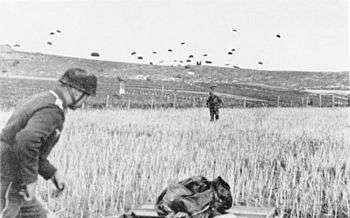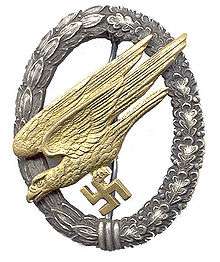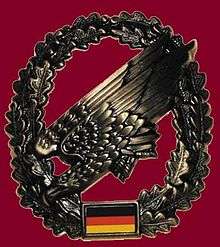Fallschirmjäger

Fallschirmjäger (German: [ˈfalʃɪʁmˌjɛːɡə]) is the German word for paratroopers. They played an important role during World War II, when, together with the Gebirgsjäger they were perceived as the elite infantry units of the German military. After World War II, they were reconstituted as parts of postwar armed forces of both West and East Germany, mainly as special ops troops.
German Fallschirmjäger in World War II were the first paratroopers to be committed in large-scale airborne operations. They came to be known as the "green devils" by the Allied forces they fought against.[1]
Etymology
The word Fallschirmjäger is from the German Fallschirm, "parachute", and Jäger, literally 'hunter,' which refers in this context to light infantry.
Nazi Germany (1935–45)
Pre-war

In the 1930s Hermann Göring, after having observed Soviet airborne infantry maneuvers, became committed to the creation of Germany's airborne infantry.[2][3] He ordered the formation of a specialist police unit in 1933, devoted to protecting Nazi party officials. The unit carried out conventional police duties for the next two years,[4] but in 1935, Göring transformed it into Germany's first dedicated airborne regiment.[4] The unit was incorporated into the newly formed Luftwaffe later that year and training commenced. Göring also ordered that a group of volunteers be drawn for parachute training. These volunteers would form a cadre for a future Fallschirmtruppe ("parachute troops").[4] In January 1936, 600 men and officers formed a Jäger and an engineer company.[5] Germany's parachute arm was officially inaugurated in 1936[6] with a call for recruits for a parachute training school. The school was open to Luftwaffe personnel, who were required to successfully complete six jumps in order to receive the Luftwaffe parachutist's badge.[6]
World War II

During World War II, the German Air Force (Luftwaffe) raised a variety of airborne light infantry (Fallschirmjäger) units. The Luftwaffe built up a division-sized unit of three Fallschirmjäger regiments plus supporting arms and air assets, known as the 7th Flieger Division. Throughout World War II, the Fallschirmjäger overall commander was Kurt Student.
Fallschirmjäger participated in the occupation of Norway and Denmark and in the battles of Belgium, the Netherlands and France in 1940. They also took part in the Balkans Campaign, Battle of Crete, Italian Campaign, and on both the Eastern Front and later the Western Front would follow.
The skillful airborne seizure of Fort Eben-Emael permitted the early capture of Belgium and, alongside successful operations in the Netherlands, was crucial for the speed of the German victories in 1940. The Battle of the Netherlands began on May 10, 1940 and ended in a German victory on May 14, 1940. German paratroopers had extreme success due to the element of surprise that occurred because of the unpreparedness of the Dutch. The Dutch were caught by surprise because of intelligence failures and miscommunication between important leaders of the Dutch military. Paratroopers played an important role in this victory because they were able to capture important targets such as the Moerdijk and Waalhaven airfields. Paratroopers also captured and defended the Moerdijk Bridge that allowed the Germans to gain a passage from Dordrecht to Amsterdam by train. This gave German soldiers an easier and quicker way important targets and to conquer the Netherlands. The major airdrops in Norway and Denmark in April 1940 were also vital to the success of the campaigns there, although they, along with the amphibious forces, suffered heavy casualties.
The Battle of Crete began on May 20, 1941 and ended on June 1, 1941. Crete was an important target for Germany because it provided territory close to the Mediterranean sea that could be used for offensive air and naval operations. German control over Crete would have also denied the Allied powers access to Germany's Ploiești oil fields in Romania where Germany gathered fifty percent of its oil.[7] Germany launched a large-scale airdrops in which the entire 7th Air Division was deployed with the German 5th Mountain Division as the follow-up. Crete was captured after fierce fighting against the Allied troops, but the high casualties suffered by the Fallschirmjäger convinced Hitler that such mass airdrops were no longer feasible. High casualties occurred because the Allied powers knew of the Operation Merkur which meant the surprise effect, essential for the success of previous operations, was no longer possible on Crete. Allied soldiers set up anti-air defence against the paratroopers. This resulted in a high casualty count, over 3250 airborne soldiers killed or MIA and 3400 wounded.[8] Fallschirmjäger were awarded a total of 134 Knight's Crosses between 1940 and 1945.
The Fallschirmjäger Divisions
After mid-1944, Fallschirmjäger were no longer trained as paratroops due to Nazi Germany's deteriorating strategic situation, and fought as infantrymen. Near the end of the war, the series of new Fallschirmjäger divisions extended to thirteen on paper, with a reduction in quality in the later units. The last three divisions to be created (11th, 20th and 21st) were never fully formed and saw no combat.
The 1st Parachute Division was formed pre-war in 1938 and was the original 'elite' Fallschirmjäger unit. It was this unit that was responsible for all of the early German airborne victories. The division surrendered in Italy of 2 May 1945.
The 2nd Parachute Division was formed in early 1943 with a core of veterans from the 1st, fully trained it was also considered to be an 'elite' formation. It fought with distinction in Ukraine in late 1943. In 1944 the division fought in western France, taking part in the Battle of Carentan and around Saint Lo. The majority of the division was then cut off and surrounded in Brest and took part in the Battle for Brest, with ended with German surrender of the city in September 1944.
The 3rd and 4th parachute divisions were formed in late 1943, around a core of veterans from the 1st and 2nd. The 4th also contained Italian paratroopers from the 184th Airborne Division Nembo. The divisions fought on the Western Front and in Italy. The 3rd fought the Normandy Campaign and was cut off and nearly destroyed in the Falaise Pocket in August 1944. It was then reformed and saw action during the Battle of Arnhem, eventually surrendering to US troops in April 1945. The 4th fought exclusively on the Italian front including the Battle of Anzio, Rome and on the Gothic Line. It surrendered to Allied forces in April 1945.
The 5th, 6th and 7th divisions were formed in 1944 in France and fought on the western front as regular infantry. The 5th was the last division to receive near full Fallschirmjäger training and was one of the few German units to achieve its objectives during the Battle of the Bulge.[9] The 6th and 7th had an overall mixed combat performance. The 5th was largely captured in the Ruhr Pocket in April 1945, the 6th and 7th surrendered at the wars end in May.
The 8th, 9th and 10th were Fallschirmjäger by name only, formed in 1945 from a disparate collection of Luftwaffe units, including ground crews. The 8th fought in the Netherlands before being destroyed in the Ruhr Pocket. The 9th fought in the Battle of the Seelow Heights and in the Battle of Berlin before being destroyed in April 1945, the 10th survived until their surrender to Soviet forces in May 1945. The 11th, 20th and 21st were divisions on paper only; never fully formed, they saw no combat.
Uniforms and equipment

A special version of the German armed forces' steel helmet was issued to Fallschirmjäger units. The RZ parachute (Rückfallschirm, Zwangablösung), German for Backpack Parachute, Static Line Deployment, used by the Fallschirmjäger in World War II is suspended from the harness via one single riser, meaning that the paratrooper had much less control of his descent than with the four riser harnesses used by British and American paratroopers. Paratroopers had to throw themselves forward out of the airplane, jumping in spread-eagle exit position, and in the resulting face-down position when the chute opened, control was nearly impossible. The necessity of landing on knees and elbows reduced the amount of equipment the trooper could carry and increased the chance of injury. The descent speed of the RZ parachute was also faster than that of the American and British rigs, making landings rougher. To remove their parachute harness, required the paratrooper to stand stationary upright for up to 80 seconds. As a result, they jumped armed only with a holstered pistol and a small "gravity knife". Rifles and other weapons were dropped in separate containers and, until these were recovered, the soldiers were poorly armed. After the Crete invasion, these faults were rectified, with the parachute harness modified to allow it to be released while prone in under 10 seconds; and the paratroopers jumped while armed with personal automatic weapons.[10]
Fallschirmjäger units were usually well equipped; they had access to the best weapons of the German military. They were among the first combat units to use assault rifles and recoilless weapons in combat. Fallschirmjäger also employed the best of several foreign-made small arms. The MP 40 and the FG 42 automatic rifle, which combined the firepower of a machine gun with the lightweight handling characteristics of a standard infantry rifle, were developed specially for the paratroopers.
Bundeswehr Fallschirmjäger (after 1945)


In the modern German Bundeswehr, Fallschirmjäger continue to form the core of special operations units. The division has two brigade equivalents and several independent companies and battalions. All told, about 10,000 troops served in that division in 2010, most of them support or logistics personnel. The division has the following structure:
- Special Operations Division
- Headquarters and Signal Company (stationed in Stadtallendorf) former time Battalion
- Army Band 300 (Koblenz)
.svg.png) Airborne Brigade 1 (Saarlouis)
Airborne Brigade 1 (Saarlouis)
 Headquarters Company (Saarlouis)
Headquarters Company (Saarlouis)- Parachute Regiment 26 1./ Staff Support Companie 2./ 3./ Parachute-Commando 4./ 5./ 6./ Parachute Companies 7./ Parachute Heavy Weapon 8./ Parachut-Support 9./ Parachute-Medical 10./Reserve
 Airborne Reconnaissance Company 260 (Zweibrücken)
Airborne Reconnaissance Company 260 (Zweibrücken) Airborne Engineer Company 260 (Saarlouis)
Airborne Engineer Company 260 (Saarlouis)- Parachute Regiment 31 1./ Staff Support Companie 2./ 3./ Parachute-Commando 4./ 5./ 6./ Parachute Companies 7./ Parachute Heavy Weapon 8./ Parachut-Support 9./ Parachute-Medical 10./Reserve
- Airborne Reconnaissance Company 310 (Seedorf)
- Airborne Engineer Company 270 (Seedorf)
- Special Forces Command (KSK) (Calw)
The vast majority of division members are deployable by parachute, and all of it is at least air mobile. Almost all vehicles and heavy equipment are transportable by helicopter, including special lightly armoured Wiesel heavy weapon transport vehicles adopted for this purpose. In addition to the Special Operations Division, Germany is also setting up an air mobile or air assault regiment.
former troops
- Airborne Air Defence Missile Battery 100 (Seedorf) - given out to Air Force
- Long Range Reconnaissance Training Company 200 (Pfullendorf) - Platoons in Airborne Reconnaissance Companies
.svg.png) Airborne Brigade 26 (Saarlouis) and
Airborne Brigade 26 (Saarlouis) and- Airborne Brigade 31 (Oldenburg) - both now Airborne Brigade 1
 Fallschirmjäger Battalion 261 (Lebach)
Fallschirmjäger Battalion 261 (Lebach) Airborne Support Battalion 262 (Merzig)
Airborne Support Battalion 262 (Merzig) Fallschirmjäger Battalion 263 (Zweibrücken)
Fallschirmjäger Battalion 263 (Zweibrücken)
- Airborne Brigade 31 (Oldenburg)
- Headquarters Company (Oldenburg)
- Fallschirmjäger Battalion 313 (Seedorf)
- Fallschirmjäger Battalion 373 (Seedorf)
- Airborne Support Battalion 272 (Oldenburg, Seedorf)
National People's Army (East Germany)


- 40. Fallschirmjägerbataillon Willi Sänger was the only airborne infantry formation of the Nationale Volksarmee (NVA). The battalion and its airborne-commando school were based in Prora on Rügen (1961–82) and near Potsdam (1982–90). Officially, the battalion was an airborne unit organized as an NVA light infantry battalion, but in reality it was considered a commando unit. On mission, the companies of the battalion were to be split up into teams of five or six men. As a force with special capabilities, it remained under the direct command of the army high command (Kommando Landstreitkräfte, KdoLaSK).
- The reconnaissance company of the Felix Dzerzhinsky Guards Regiment (German: Wachregiment "Feliks E. Dzierzynski"), an elite motorized rifle regiment of the Ministry for State Security of the German Democratic Republic (GDR), was a parachute-trained unit.
Bibliography
- Ailsby, Christopher (2000). Hitler's Sky Warriors: German Paratroopers in Action, 1939-1945. Staplehurst, UK: Spellmount Limited. ISBN 1-86227-109-7.
Bell, Kelly. "Costly Capture Of Crete." World War II 14.1 (1999): 50. MasterFILE Complete. Web. 22 Oct. 2014.
External links
References
- ↑ Green Devils: German Paratroopers 1939-1945 By Jean-Yves Nasse, W. Muhlberger, G. Schubert, Jean-Pierre Villaume,
- ↑ Ailsby, 16
- ↑ Ailsby, 21
- 1 2 3 Ailsby, 22
- ↑ Ailsby, 23
- 1 2 Ailsby, 26
- ↑ Murray, Williamson. "Airborne Comes Of Age." World War II 18.7 (2004): 26. MasterFILE Complete. Web. 22 Oct. 2014.
- ↑ McNab, Chris. German Paratroopers: The Illustrated History of the Fallschirmjäger in World War II. London: Aurum, 2000. Print.
- ↑ http://www.historicalwarmilitariaforum.com/topic/8-gliederung-5-fallschirmj%C3%A4ger-division/
- ↑ Comparison of the Invasion of Crete and the Proposed Invasion of Malta, by S Kavanaugh, 1994 http://www.dtic.mil/cgi-bin/GetTRDoc?Location=U2&doc=GetTRDoc.pdf&AD=ADA452022